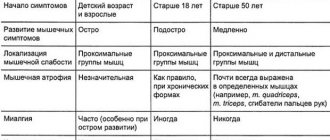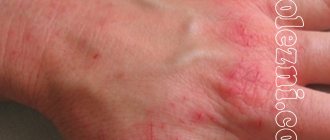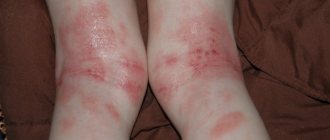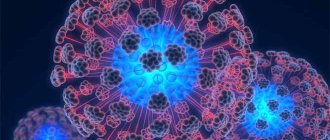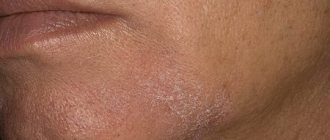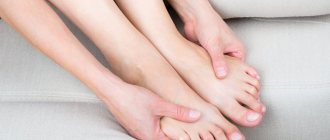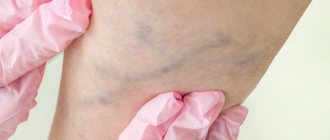- Home >
- Symptoms >
- Pins and needles, goosebumps, numbness in hands
All sorts of unusual sensations in the hands - pins and needles, goosebumps running down the arm, burning, numbness - are called paresthesia in medicine. There are a lot of possible causes for this phenomenon, and therefore the treatment of pins and needles, goosebumps and other strange manifestations of various diseases is not universal.
Etiology
The most common reason for this specific manifestation is that the hands are in an uncomfortable position for a long time. In this case, the blood vessels are compressed, which prevents blood from flowing into the fingers and palms, and a tingling sensation appears in the upper extremities.
This condition is considered completely normal, but only in cases where it is expressed rarely and for a short time. Otherwise, predisposing factors should be sought from pathological processes.
Thus, the most common sources of tingling in the palms, fingers or hands are:
- the course of diabetes mellitus;
- dysfunction of the thyroid gland;
- insufficient intake of substances such as calcium, potassium and vitamin B12 into the body;
- cardiovascular pathologies;
- uncontrolled use of medications;
- wide range of allergic reactions;
- animal or insect bites;
- arterial hypertension;
- hypothyroidism and paresthesia;
- arrhythmias of any type;
- simple fatigue and lack of rest.
All of the above factors can affect the appearance of tingling in both hands, however, there are several reasons that cause the occurrence of a similar symptom in only one limb.
For example, tingling in the left hand can be caused by:
- dehydration due to food poisoning or medication overdose;
- menopause and other conditions leading to hormonal changes in the female body;
- insufficient concentration of sugar in the blood;
- spasm of blood vessels localized in the brain;
- vitamin B complex deficiency;
- stroke or heart attack;
- various neoplasms in the spine, in particular intervertebral hernia - in this case, tingling will be noted not in the hand, but at the fingertips;
- Raynaud's syndrome - the disease can develop against the background of abuse of bad habits, poor nutrition or emotional stress. It is noteworthy that discomfort often occurs at night;
- spasms of the vessels of the left hand - this affects people who are forced to remain in one position for a long time, due to professional duties;
- the course of the oncological process in the nervous system;
- osteochondrosis and arthritis;
- long-term radiation therapy;
- arthrosis or diseases of infectious origin.
Intervertebral hernia is a possible cause of tingling hands
The occurrence of a similar sensation in the right hand is mainly explained by professional activities, but etiological factors can also be represented:
- circulatory disorders;
- injury to the hand or shoulder joint on the right side of the body;
- intervertebral hernias;
- constant carrying of heavy objects;
- tunnel syndrome;
- excess body weight;
- diabetes mellitus;
- spinal injuries in the cervical region;
- frostbite on the hand;
- migraine and other neuropathies;
- pathologies of the kidneys and urethra, most often caused by urethritis;
- osteochondrosis;
- sudden jumps in blood tone;
- long-term psychological disorders or stressful situations;
- disruption of lung function.
Stages and degrees of diseases that cause tingling in the hands
Tingling in the hands like needles is often a consequence of osteochondrosis. The pathology is associated with a violation of the morphology of the structure of the bones of the spine. Late stages are characterized by pinched nerve roots, which causes tingling and pain. Tingling is localized in the hands and thumb area. At the same time, the mobility of the spine is limited.
With dislocation of the vertebrae, which is a dangerous process, tingling has the same manifestations as with osteochondrosis, but the pain is more pronounced.
With tunnel syndrome, nerve roots are pinched due to inflammation in nearby tissues . The median nerve of the wrist is affected, as well as the nerves in the elbow.
Carpal tunnel syndrome causes pins-and-needles tingling and numbness in the arms
Tingling can be caused by poor circulation due to vascular and heart diseases. A pronounced symptom can signal the development of pathologies such as stroke, heart attack, angina.
Pins and needles in the hands are felt when a tumor develops in the brain. With thrombosis of the hands, not only tingling is felt, but also numbness. If you do not seek advice on time, the hand tissues die.
In diabetes mellitus, the morphology of peripheral nerves is disrupted due to disruption of processes at the biochemical level. The nerves of not only the arms, but also the legs are affected.
Symptoms
Due to the fact that tingling in the left hand or in the right upper limb in the vast majority of cases is caused by the course of one or another illness, it becomes clear that the clinical picture will not be limited to just this symptom.
It follows from this that the symptom complex will consist of signs characteristic of the provoking disease, which means that a wide range of manifestations can serve as additional symptoms.
You should definitely seek qualified help when expressing:
- disturbances in urination or bowel movements;
- inability to move immediately after waking up;
- lack of sensitivity in the fingers of the affected limb;
- short-term impairment of consciousness;
- decreased visual acuity and cough;
- deterioration of speech ability;
- frequent seizures;
- muscle weakness and spasms;
- sensation of “goosebumps” on the skin;
- the appearance of numbness, which increases with physical activity;
- the occurrence of pain in the neck and shoulders;
- spreading tingling throughout the body, in particular to the lower extremities;
- changes in the temperature of the affected hand - it often becomes cold.
The most dangerous situation is considered to be one in which an unreasonable tingling sensation occurs on the left hand, since it is located closer to the heart than the hand on the right. An equally alarming sign is constant tingling or numbness in both hands.
Symptoms of diseases that cause tingling in the hands
Raynaud's disease is characterized by the manifestation of paroxysmal spasms of the smallest vessels of the upper extremities during cold or emotional stress.
During the ischemic phase of the disease one feels:
- vasospasm;
- disruption of blood flow;
- chilliness.
During the cyanosis phase, the skin turns blue, the tingling sensation and pain subside slightly. During the hyperemia phase, the skin turns red due to compensatory blood flow. The pain and tingling go away. With Raynaud's disease, in addition to tingling, there are other symptoms.
The patient complains of the following symptoms:
- numbness of the fingers of the upper and lower extremities;
- burning sensation;
- loss of temperature sensitivity;
- paresthesia of the arms and legs;
- dry skin.
Arthrosis is a degenerative pathology that affects the joints. In the initial stages, no tingling is observed. As the disease progresses, bone growths develop, which begin to put pressure on the joint and surrounding tissues.
The process calls:
- numbness of hands;
- tingling feeling;
- pain.
In particular, the symptoms become more pronounced with the development of joint swelling. Anemia causes a lack of oxygen in the blood and deterioration in the nutrition of tissues and organs. When blood vessels and nerve endings are damaged as a result of injury, numbness and tingling occurs over a period of time.
In case of cerebrovascular accident, in addition to tingling in the hands, the following is felt:
- difficulty speaking;
- numbness in the facial area;
- weakness in the legs;
- dizziness
- sweating;
- involuntary release of urine.
With osteochondrosis, tumor, or spinal injuries, the patient may be concerned about:
- migraine;
- dizziness;
- crunch in the vertebrae;
- visual and hearing impairment.
With inflammatory damage to the muscles of the cervical spine, fever and neck pain may occur.
When calcium levels are low, the following are observed:
- convulsions;
- numbness of the face;
- tingling in the hands.
Diagnostics
Determining the cause that led to severe tingling in the hand is a rather labor-intensive process. If such a symptom occurs, you can consult:
- neurologist;
- cardiologist;
- therapist;
- endocrinologist.
One of these specialists will be able to conduct a full diagnosis and prescribe treatment.
Thus, in order to establish the cause of tingling in the left hand or in the right hand, the following diagnostic measures are necessary:
- studying the medical history and collecting the patient’s life history;
- a thorough physical examination to check reflexes in the upper extremities;
- a detailed survey of the patient - to establish the first time of onset of the main symptom and the severity of additional symptoms;
- general clinical blood test;
- measuring the concentration of vitamin B and blood sugar;
- blood test for thyroid hormones;
- general urine analysis;
- laboratory study of cerebrospinal fluid;
- assessment of nerve conduction velocity;
- skin or nerve biopsy;
- angiogram and Doppler study of blood vessels;
- X-ray of the affected hand;
- electromyography and ultrasound of blood vessels;
- lumbar puncture and cold stimulation;
- CT and MRI;
- consultations with specialists from other fields of medicine.
Performing a lumbar puncture
pads
Tingling in the fingertips of the left hand often occurs due to systemic diseases. A similar symptom occurs in the event of a blood supply disorder. The phalanges of the fingers change color. They turn red or white.
Tingling in the fingertips of the left hand sometimes indicates the development of diabetes. They are also caused by neurotrophic changes. If there is tingling in the tips of not all, but only a few fingers, it is recommended to check the condition of the spine.
Treatment
Eliminating tingling in the hands requires an integrated approach, which means that it includes the following techniques:
- taking medications to thin the blood and manual therapy - this is necessary to stabilize blood flow, relax the arm muscles and relieve pain in the joints, which provokes compression of the nerve endings;
- a wide range of physiotherapeutic procedures to activate peripheral circulation;
- performing gymnastic exercises and exercise therapy;
- course of therapeutic hand massage;
- drug therapy of the underlying disease;
- surgical intervention - in cases where an intervertebral hernia or tumor of any localization is detected during diagnosis;
- the use of hormonal substances – for thyroid dysfunction;
- a variety of rehabilitation measures - indicated for patients suffering from nervous system disorders.
Tactics on how to treat tingling in the hands are drawn up individually for each patient, taking into account the following factors:
- severity of the underlying disease;
- age category of the patient;
- degree of severity of the main clinical sign;
- the presence of concomitant symptoms;
- possible complications.
Preventing tingling in the hands
Some preventive measures should be followed:
- stop drinking alcohol and smoking;
- exercise regularly;
- do not overwork;
- adhere to a balanced diet and drinking regime;
- avoid nervous tension;
- avoid;
- take medications strictly as prescribed by the doctor;
- strengthen immunity;
- provide adequate rest;
- undergo a full course of examination by a therapist for timely relief of pathologies;
- control blood pressure.
Tingling in the hands is not an isolated symptom; the feeling of needles is a consequence of the development of a serious pathology in the body. Modern diagnostics increases the likelihood of a favorable outcome. Lack of treatment can lead to complications.
It feels like there are goosebumps on the left shoulder - online doctor
When people experience strong emotions, they often experience a feeling of goosebumps under their skin. This condition usually does not pose a danger to humans; only long enough and frequently occurring goosebumps can indicate some problems in the body.
Features of the condition and its causes
Patients usually call “goosebumps” the feeling that occurs when “goose bumps” appear—small pimples at the base of small hairs on the skin. The sensation usually appears when a person is cold or if he is afraid of something, experiences delight or sexual arousal. Also, people often use the expression “the hair stood on end.”
The goosebumps themselves can cause:
This condition is especially frightening for people who cannot understand what is happening to them. Overly sensitive individuals may even begin to suspect that they have a dangerous disease, which will only worsen the situation.
The occurrence of a symptom can be due to many reasons. As a rule, the following ailments can lead to goosebumps: low levels of calcium or magnesium, lack of vitamin B1, multiple sclerosis, spinal pathologies, migraines, varicose veins, lesions of the parietal lobe of the brain, etc. Another common cause of goosebumps is often vegetative-vascular dystonia.
How is the symptom related to VSD?
It is known that the development of VSD is caused by mental instability of the individual, which manifests itself in excessive exposure to fear, depression and stress. Such patients often suffer from various undesirable symptoms, one of which is goosebumps. In this case, the symptom is accompanied by the following manifestations:
People who suffer from phobic disorders and are under intense psychological stress may regularly experience a sensation of chills crawling down their spine. They are able to feel fear not only in situations of direct contact with the object of fear, but even simply when thinking about their fears.
A “threat” for them can be associated with anything: from people around them who may suddenly talk about a painful topic, to films and television shows that are somehow related to “danger.” Anxiety and worry haunt such individuals constantly, as a result of which patients develop “goose bumps”.
What should the therapy be like?
To prevent the occurrence of certain unpleasant symptoms, first of all, it is recommended to protect yourself from stressful situations. In the early stages, you can fight the problem caused by VSD and psychogenic disorders on your own.
- You should spend time as often as possible with people who evoke positive emotions and make you forget about the bad for at least a few hours. On the contrary, it is necessary to communicate with those individuals who bring negativity into life as little as possible.
- Physical exercise has a healing effect on the psycho-emotional state. Jogging and morning exercises are a good way to distract yourself from heavy thoughts. In addition, water procedures should not be neglected.
- You need to be able to live in the present and not burden yourself with negative thoughts about what will happen ahead. It is worth learning to appreciate every moment you live and enjoy the little things. Seemingly insignificant details can significantly lift your mood and improve your well-being.
It should also be remembered that certain lifestyle habits can significantly worsen the condition.
- Frequent drinking of alcoholic beverages, smoking.
- Lack of physical activity. Lack of exercise can also affect your health.
- Long-term use of antibiotics or other strong medications.
- Using medications without a doctor's prescription. Also, you should not abuse the use of folk remedies.
- Exhausting diets or overeating.
- Lack of certain vitamins and minerals in the body.
Goosebumps run all over the body for no reason only at first glance - in fact, there are reasons for the occurrence of any symptom. In severe cases, with unsuccessful attempts to cope with the problem on your own, it is recommended to consult a psychotherapist.
If the sensation of goosebumps manifests itself too intensely and is accompanied by symptoms such as swelling, headaches, blurred vision and memory, you should immediately seek medical help and undergo a prescribed examination.
Source: https://onlinvrach.ru/u-levogo-plecha-kak-budto-begajut-murashki.html
